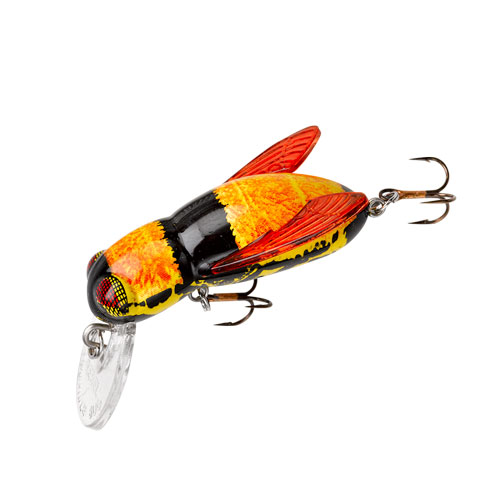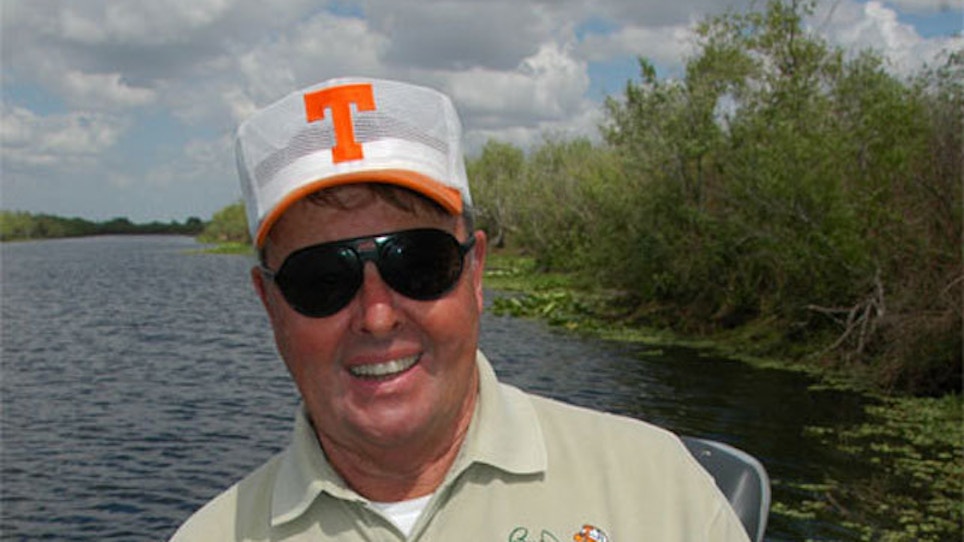By Bill Dance
I love to wade creeks and fish small ponds and lakes. Fishing knee deep and casting for bass brings back memories of when I was a kid, and it is still one of my very favorite ways to spend a summer day.
Light “finesse” tackle is perfect for this kind of fishing. It resembles ultra-light gear, but the length and the action of the rods are different. The traditional ultra-light tends to come with soft action in a 4 1/2- to 5-foot length. A finesse rod averages 6 to 6-1/2 feet with some in the 7-foot range. It is a little stiffer and more sensitive, and it allows you to handle a good fish more effectively and to deliver a better hookset.
Like ultra-light, finesse tackle employs a small spinning reel and light line. Select a reel that balances with your rod. If it’s too heavy it overpowers the rig. Generally, I like a size 10 reel with a high retrieve speed and an aluminum long-cast spool. My Quantum Accurist spinning reel is so small that you can palm it, and it weights less than 6 ounces, yet it holds 140 yards of 6-lb line, which is perfect for the casting distance and strength I need.
Finesse tackle opens the doors to a wide variety of lures, not just the small jig or feather-weight lures required by true ultralight gear. Here are some of my absolute favorites.
Rebel Teeny Wee Crawfish
More than 1,200 species of crawfish live in creeks, ponds and lakes across the country and around the world. A favorite imitation of this preferred bass forage is the Rebel Teeny Wee Crawfish, which runs about 3-feet deep, and the Rebel Wee-Crawfish, which gets down to the 5- to 7-foot depths.
The secret to working this floater-diver is to simulate the erratic action of a real crawdad by imparting a strategic ‘stop-and-go’ into the presentation. Watch a crawfish under water. He will move fast, then just glide real slowly…dart…then glide.
A steady, constant retrieve will not duplicate that movement (although it does catch fish), so I like to crank the lure down to its designated depth, then stop it. A lot of times I pull it, stop it, then reel three or four turns real slowly, then reel it fast a few quick turns. Always mix your presentation with stop and go, but don’t overpower the bait. You want to make it look as natural as possible.
Rebel Frog-R
The Heddon Zara Spook introduced bass fishermen to a technique we call “walk the dog,” but, thanks to a short, squatty lure that mimics a crippled amphibian struggling at the surface, we have a take-off of that presentation I call “walking the frog.”
The Rebel Frog-R is a bug-eyed little bait without a diving lip or propeller to give it action. It has body mass and surface swimming action that the angler creates. In other words, you have to put life into the bait.
Now, you can’t do that with a pool cue. You need a rod with light tip action. But in the hands of a skilled angler, this bait has amazing action that is perfect for pond bass.
No one becomes an expert with this bait all at once. It takes practice and a lot of eye, wrist, and rod tip coordination to produce that side-to-side walking action. I like a “1-2-3-pause, 1-2 pause…then repeat” approach. The hard part is reeling one-half turn at the same time you are bringing your rod tip down. The downward action swings the lure to the side. Raising the rod lets the lure swing back in the opposite direction.
Keep 12 to 14 inches of slack in your line. It takes practice to get the proper cadence and coordination, but walking a frog – or dog – is a technique well-worth learning. When you perfect the technique, that squatty lure will walk the walk and talk the talk.
 Rebel Bumble Bug
Rebel Bumble Bug
A bass’s daily diet isn’t always a mix of just crawfish and baitfish with a little frog leg appetizer. Watch feeding activity in ponds and lakes. You will see that fish eat insects like crazy! Crickets, grasshoppers, mayflies and bees hit the water and struggle side-to-side or go in circles…and bass hit them!
The Rebel Bumble Bug is one of those tiny crankbaits that will catch fish most of the time if you are fishing it in the right location with the right retrieve. It shines when the fishing is slow or when fish are feeding on small food items. It is also great when you are fishing a heavily pressured shoreline, along warming banks in winter and in the backs of coves and hollers in the fall.
The key to the Bumble Bug’s effectiveness is the presentation. After it hits the surface, allow it to sit. Then twitch it a couple times, reel it under the surface, and stop to let it float back to the top. Like the bumblebee it is patterned after, it has two wings, so it zig-zags as it rises to the surface.
Rebel Teeny Pop R
Bass fishing is often a shoreline affair. We find pleasure and solitude near the bank as we watch raccoons and snakes and deer. And, with topwater lures, we fish with excitement and anticipation as we watch for a bass to blow up on our bait.
You’ll find more than 30 popping/chugging lures on the market. Some are better than others, but one of the most endearing is the Rebel Pop-R. The Pop-R has a baitfish profile and a concave “popping “ mouth. Its profile as it lies in the water looks natural, and it is engineered with the whole mouth out of the water, enabling it to walk and pop better. The feathered rear hook looks like a shad tail.
The Pop-R family comes in several sizes, all of common baitfish dimensions. At a mere 2-inch length, the Rebel Teeny Pop R is the smallest.
The key to fishing any Pop-R is to establish a pattern and rhythm. The retrieve I use most frequently is three pops and a pause – pop, pop, pop, pause…pop, pop, pop, pause. A faster, more erratic retrieve is best in late spring when bass are bunched up. At other times of the year, I am inclined to mix my retrieve up, switching off from fast to slow, and varying the frequency and length of the pause. It pays to experiment.






